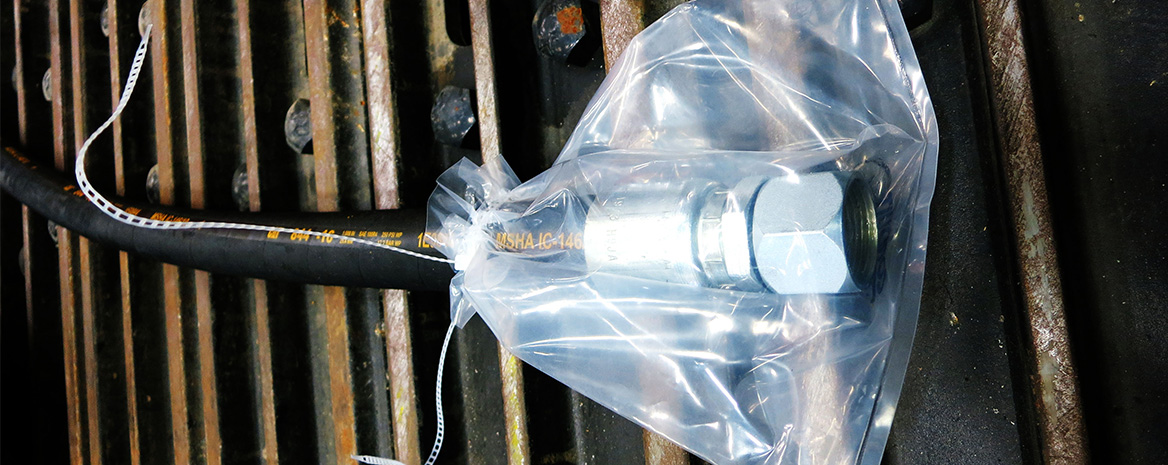KEEPING YOUR EQUIPMENT CLEAN
Contamination can rob your machine of efficiency and cause premature component failure. We work hard to keep manage your machines’ contamination control, while in the shop, by maintaining a clean repair process, clean facilities, and clean components.
Did you know that a particle just 5 microns wide can damage your fuel system? For perspective, the average human hair is 80 microns wide. This means your system can be damaged by particles that are too small to see. It’s easy to see how contamination happens, but what are the sources?
- FUEL: Contamination can occur during fuel transportation and storage. For the life of your machine and components, it is critical to have a reliable supplier, filtered dispensing, and the periodic sampling offered through our S.O.S lab.
- OPERATION: If your fuel tank vent isn’t sealed properly, you risk fuel contamination from airborne particles. To help, watch your fuel tank vent and engage in regular fuel sampling.
- EXTERNAL: Contamination can occur any time someone works on your equipment. Whether it’s maintenance, service, or filter changes we have you covered with expert technicians and industry-leading contamination control procedures.
Contamination control is vital to ensuring you get the most out of your machine. We use a range of processes, certified by Caterpillar, to ensure your components are kept contaminant free during servicing.
Our contaminant control process includes:
- ANALYSIS: in our S.O.S lab, providing the assurance that particle counts meet Caterpillar standards and oil is working properly for your equipment
- FILTRATION: if necessary and appropriate. Your oil can be filtered or kidney looped to meet Caterpillar standards
- REPLACEMENT: or filling with the highest standard in fluids
- COMPONENTS: and hoses kept fully protected and clean and assembled in shops that set the industry standard for cleanliness
- INSTALLATION: and removal completed in dedicated areas
Learn to inspect your equipment and detect problems before they impact your operation, watching closely for drops in efficiency or early signs of component failure. You can help keep your machines contaminant free by taking preventative precautions.
Start by understanding contamination. Particulate contamination will grind away at your components. While they are, by far, the most common type of contaminant, they are also the easiest to control. Chemical contamination includes heat, water, and air that combine to break down the oil’s chemical composition through oxidation and acid production.
You can control contamination through the following:
The Basics
- CLEANLINESS: Keep floors, workbenches, and other work surfaces clean and contaminate-free.
- ACCOUNTABILITY: Hold your crew accountable for cleanliness and machine checks.
- PROTECTION: Ensure that work in progress is covered and protected from airborne contamination.
- QUALITY: Use High-quality oil and filters, replacing them regularly.
- COVER: Use tight-fitting barrel covers for all stored fluids to prevent contamination.
- CLEAN: Keep hoses and components clean during assembly and protected during storage.
- SCHEDULE: Follow regular checks and maintenance schedule. Talk to us about our S.O.S lab and Customer Value Agreements to ensure you are getting the best service scheduling possible.
During Operation
- TEMPERATURE: Monitor system temperatures for excess heat that can increase oxidation, bake seals, and blister hoses.
- PROTECT: When dealing with banked rock or dry applications consider protective covers for exposed rods.
- INSPECT: When changing hydraulically driven work tools, inspect couplers and wipe dirt from disconnects before coupling. Perform daily equipment inspections as well.
- LISTEN: On-site, your operators live in the equipment. They will be the first to notice a concern and are one of your best sources for catching problems early. Ask to be notified about operation concerns such as abnormal drift or noise.
- NOTICE: Take the time to notice leaks, wear or pitting that can allow dirt to enter your systems.
- MAINTAIN: Take care in maintaining oil cooler and relief valves as well as fan belts, radiators, and oil coolers.
10 Hour/Daily
- Check hydraulic fluid levels.
- Check hydraulic cylinders and pumps for leaks.
- Check hoses, lines, and hydraulic tanks for leaks or damage.
250 Hour/Monthly Contamination Control
- Ensure that all 10 Hour inspections have been completed.
- Check hydraulic oil cooler for leaks or plugs.
- Check hydraulic lines for damaged, missing, or lose connections.
500 Hour/Quarterly Contamination Control
- Ensure that all 10 and 250 Hour inspections have been completed.
- Perform S.O.S Service for fluids.
- Change Filters.
- Check pumps and mountings for loose or missing hardware.
1000 Hour/Six Month Contamination Control
- Ensure previous inspections were completed.
- Check pump and weep holes for leaks.
2000 Hour/Annual Contamination Control
- Ensure previous inspections were completed.
- Check fluid system pressures.
- Check timing cycles and drift rates.
- Stall test the hydraulic system.
